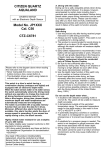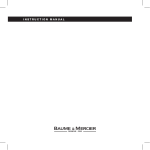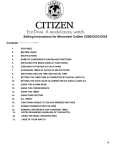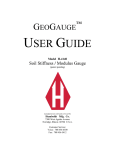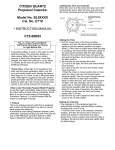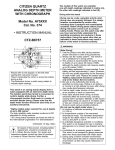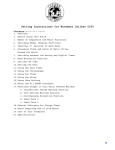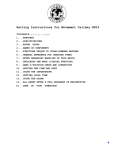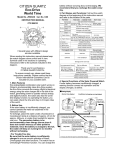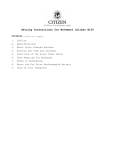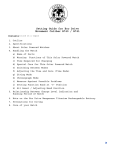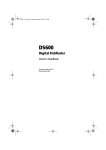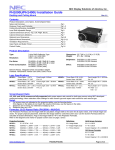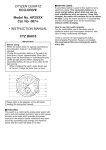Download Citizen C300 Instruction manual
Transcript
CITIZEN QUARTZ NAVIHAWK Model No. JNOXXX Caliber No. C300 • INSTRUCTION MANUAL CTZ-D6758 This combination watch can display the time in 30 cities of the world with a simple operation. In addition to the time displayed in the analog section, the times in 30 cities can be displayed in analog and digital can easily be switched. This watch is a useful tool for various purposes, such as on the international business scene and when travelling. Names and Functions Look at the watch diagram at the beginning of this instruction manual and refer to the location of the parts. Names of Parts: [ 1 ] Minute hand [ 2 ] Hour hand [ 3 ] UTC Time Indicator (Displays Coordinated Universal Time in hours and minutes) [ 4 ] Mode hand (Shows the mode selected with the M button) [ 5 ] 24-hour hand [ 6 ] Displays the name of the city for which the time is displayed in the digital section [7] [ 7 ] Displays the time or calendar [ 8 ] Displays the functions of the A button [ 9 ] Displays the functions of the M button [ 10 ] Displays the functions of the B button [ 11 ] Displays the functions of the C button Main Functions 1. Displaying the Time in 30 Cities of the World The Coordinated Universal Time (UTC) and the time in 30 cities of the world can easily be displayed. Operation: Press the M button to move the mode hand to [TME]. The name of and time in a city will be displayed at [6] and [7] and change in sequence each time the A (UP) or C (DOWN) button is pressed. • The time in the analog and digital section can be switched. Operation: Press the M button to move the mode hand to either [TME] or [CAL]. Press the A and C buttons simultaneously to switch between the analog and digital section. 2. Displaying the Calendar in 30 Cities of the World The calendar in 30 cities of the world can easily be displayed. Operation: Press the M button to move the mode hand to [CAL]. The name of and calendar for a city will be displayed in [6] and [7] and change in sequence each time the A (UP) or C (DOWN) button is pressed. 3. Three Alarms The watch has three alarms, each with a different tone. Each alarm can be set for the time in any one of thirty cities. See “Using the Alarm” for details. 4. Chronograph The time can be measured up to 23 hours, 59 minutes, 59 seconds and 99 hundredths of a second, displayed in increments as small as one-hundredth of a second (1/100 sec). See “Using the Chronograph” for details. 5. Timer The countdown timer can be set from 1 to 60 minutes in increments of 1 minute. See “Using the Timer” for details. 6. Zone Setting The time displayed can be programmed so that only the desired cities are displayed. Using the zone setting function allows you to display the desired time and calendar for a city more efficiently. See “Using the Zone Setting function” for details. Changing Modes The mode changes each time the M button is pressed. The current mode during operation can be confirmed with the mode hand [4]. The modes change in the following sequence: [TME] ➡ [CAL] ➡ [AL-1] ➡ [AL-2] ➡ [AL-3] ➡ [CHR] ➡ [TMR] ➡ [SET] Using the Zone Setting Function This page should be read with the watch diagram, on the first page of this manual, showing the location of the parts. The Time Difference Between the Cities Indicated by this Watch and Greenwich Mean Time This watch can display the time in 30 cities of the world in sequence. Using the zone setting function allows you to skip the cities you do not wish displayed. [ Preparation for zone setting ] Press the M (MODE) button to move the mode hand to [SET]. (At this point, the cities to be displayed or to be skipped can be confirmed by using either the A [UP] or C [DOWN] button.) [ Zone setting – Display/No Display] 1. Pull the M (MODE) button out to the setting position. 2. Use the A (UP) button to select the cities. 3. Use the B (SET) button to select either SET (display the time) or OFF (do not display the time). 4. Use the C (SET) button to select daylight-saving time ON or OFF. 5. Push the M (MODE) button to its normal position. Zone setting is now completed. 6. Press the M (MODE) button to return the mode hand to [TME]. Adjusting the Time This page should be read with the watch diagram, on the first page of this manual, showing the location of the parts. Adjusting the time for one of the 30 cities will automatically adjust the time for the remaining cities according to the time differences. [Preparation for time adjustment] 1. Press the M (MODE) button to move the mode hand to [TIME]. 2. Press either the A (UP) or C (DOWN) button to move to the desired city. The name of the city will be displayed at [6]. [Time adjustment] 1. Pull the M (MODE) button out to the setting position. The time is displayed in the digital section with the hours, minutes and seconds blinking. (At this point, daylight-saving time ON/OFF can be selected by pressing the C (SET) button.) 2. Press the A (SELECT) button. The desired segment of hours, minutes or seconds will blink in sequence. The segments blink in the following sequence: [hours, minutes and seconds] ➡ [seconds] ➡ [minutes] ➡ [hours] ➡ [switching between 12- and 24-hour systems] ➡ [hours, minutes and seconds]. 3. Use the C (SET) button to adjust the blinking segment. 4. Push the M (MODE) button in to its normal position. Time adjustment is now completed. Adjusting the Calendar This page should be read with the watch diagram, on the first page of this manual, showing the location of the parts. Adjusting the calendar for one of the 30 cities will automatically adjust the calendar for the remaining cities, according to the time differences. [Preparation for calendar adjustment] 1. Press the M (MODE) button to move the mode hand to [CAL]. 2. Press either the A (UP) button or C (DOWN) button to select the desired city. [Calendar adjustment] 1. Pull the M (MODE) button out to the setting position. The day of the week (MO, TU, etc.) displayed in the digital section disappears and the month number starts blinking. 2. Press the A (SELECT) button. The desired segment of the date will blink in sequence. The segments in the following sequence: [month] ➡ [date] ➡ [year] ➡ [month] 3. Use the C (SET) button to adjust the blinking segment. 4. Push the M (MODE) button in to its normal position. Calendar adjustment is now completed. *There is no need to adjust the day of the week since it is corrected automatically. Using the Alarm This page should be read with the watch diagram, on the first page of this manual, showing the location of the parts. The operation of Alarms 1[AL-1], 2[AL-2] and 3[AL-3] are the same; only their tones are different. Once an alarm is set, it sounds at the same time every day until it is cancelled (set to OFF). [Preparation for alarm setting] Example: Setting AL-1 1. Press the M (MODE) button to move the mode hand to [AL-1]. 2. Press either the A (UP) or C (DOWN) button to select the desired city. [Alarm setting] 1. Pull the M (MODE) button out to the setting position. 2. Press the A (SELECT) button. The desired segment of the time will blink in sequence. The segments blink in the following sequence: [Alarm ON/OFF] ➡ [hours] ➡ [minutes] ➡ [alarm ON/OFF] 3. Use the C (SET) button to adjust the blinking segment. 4. Push the M (MODE) button in to its normal position. Alarm adjustment is now completed. 5. Press the M (MODE) button to return the mode hand to [TME]. * To turn the alarm off, press either the A, B, C or M button. Using the Chronograph This page should be read with the watch diagram, on the first page of this manual, showing the location of the parts. In addition to the normal function of measuring the time from a starting to a stopping point, this chronograph has a split time function that enables you to measure elapsed time at any point from start to finish. [Preparation for using the chronograph] Press the M (MODE) button to move the mode hand to [CHR]. [Using the chronograph - 1] 1. Pressing the A (START) button starts time measurement. 2. Pressing the A (STOP) button stops time measurement. 3. Pressing the C (RESET) button returns the displayed numbers to zeros. [Using the chronograph - 2] 1. Pressing the A (START) button starts time measurement. 2. Pressing the C (SPLIT) button returns the elapsed time for 10 seconds. (This function is useful in measuring elapsed time upon passing a point during a marathon, etc.) 3. Pressing the A (STOP) button stops the time measurement. 4. Pressing the C (RESET) button returns the displayed digits to zeros. Convenient Functions This page should be read with the watch diagram, on the first page of this manual, showing the location of the parts. Using the Timer This page should be read with the watch diagram, on the first page of this manual, showing the location of the parts. The timer can be set from 1 to 60 minutes in increments of 1 minute. [Preparation for using the timer] 1. Press the M (MODE) button to move the mode hand to [TMR]. 2. Pull the M (MODE) button out to the setting position. 3. Use the C (SET) button to set the time for the timer. 4. Push the M (MODE) button in to its normal position. Now timer setting is completed. [Using the timer - 1] 1. Pressing the A (START) button starts the countdown. (When the set time has expired (time up), the watch beeps for 5 seconds.) 2. Pressing the A (STOP) button stops the countdown. 3. Pressing the C (RESET) button resets the timer back to the set time. [Using the timer - 2] 1. Pressing the M (MODE) button starts the countdown. 2. Pressing the C button resets the timer back to the set time and restarts the countdown again. (This function is useful in restarting the countdown quickly.) 3. Pressing the A (STOP) button stops the countdown. 4. Pressing the C (RESET) button resets the timer back to the set time. When the hands of the analog section cover the digital section, making the time in digital difficult to read, utilise the – Hand-retractor function: Use this function to retract the hour and minute hands of the analog section to the 12 o’clock position. [Operation] Hold the B button down for 2 seconds and then release it when “H.R” blinks in [10]. *During Hand-Retractor mode the minute hand of the UTC time at [3] goes back and forth by 1 minute (-1 minute +1 minute), and “H.R” displayed at [10] blinks. [Cancelling Hand-Retractor mode] B button again cancels HandPressing the Retractor mode. (H.R.: Abbreviation of Hand-Retractor) When the watch displays something improperly and a malfunction is suspected, perform – ALL RESET and zero positioning: When the watch displays something improperly and a malfunction is suspected, perform ALL RESET and zero positioning, then readjust the time, calendar and other modes. [ALL RESET] This function can be operated from any mode. M (MODE) button out to the setting 1. Pull the position. A, B and C buttons 2. Hold down the simultaneously for more than 2 seconds then release them. (All digital segments will light up. Immediately reset to the zero position.) [Zero positioning] 1. Pressing the B button resets all segments in the digital section to zeros. 2. The digital display changes in the sequence of B button is UTC ➡ HR ➡ MIN each time the pressed. UTC: For zero positioning of the UTC time display HR: For zero positioning of the hour hand and 24-hour hand MIN: For zero positioning of the minute hand. A (UP) button turns each hand 3. Pressing the clockwise. Pressing the C (DOWN) button turns each hand counterclockwise. Align all hands to the 12 o’clock position. M (MODE) button is pushed in to its 4. When the normal position, the watch beeps and at the same time the hands start moving. ALL RESET and zero positioning are now completed. 5. Set the time, calendar and other modes. *Zero positioning can also be done in Chronograph mode. M (MODE) button to align the mode 1. Press the hand to [CHR]. M (MODE) button to its outward 2. Press the position. 3. The digital segments change in the sequence B button of UTC ➡ HR ➡ MIN each time the is pressed. UTC: For zero positioning of the UTC time display HR: For zero positioning of the hour hand and the 24-hour hand MIN: For zero positioning of the minute hand A (UP) button turns each hand 4. Pressing the C (DOWN) button clockwise. Pressing the turns each hand counterclockwise. Align all hands to the 12 o’clock position. A (UP) button is pushed back in to 5. When the this normal position, the watch beeps and at the same time the hands start moving. Zero positioning is now completed. 6. Set the time, calendar and other modes. Using the Register Ring [Calculation function] Note the following points when using this function. Use the calculation function of this watch only as a guide. Scales like these cannot, place a decimal point for you. A. Navigational calculation 1. Time required Example: Obtain the time required for the flight of an aircraft at 180 knots for 450 nautical miles. Answer: Align “18” on the outer scale with the SPEED INDEX (▲) on the inner scale. Then, “45” on the outer scale corresponds to “2:30” on the inner scale (time scale). Thus, the time required for the flight is 2 hours and 30 minutes. 2. Knots (air speed) Example: Obtain the knots (air speed) for 240 nautical miles with a flight time of 1 hour and 20 minutes. Answer: Align “24” on the outer scale with “1:20” on the inner scale (time scale). Then, the SPEED INDEX (▲) on the inner scale corresponds to “18” on the outer scale. Thus, the air speed for the flight is 180 knots. 3. Flight distance Example: Obtain the air distance when the air speed is 210 knots and the flight time is 40 minutes. Answer: Align “21” on the outer scale with the SPEED INDEX (▲) on the inner scale. Thus, the air distance of the flight is 140 nautical miles. 4. Rate of fuel consumption Example: Obtain the rate of fuel consumption (gallons/hour) when the flight time is 30 minutes and the fuel consumption is 120 gallons. Answer: Align “12” on the outer scale with the “30” on the inner scale. Then, the SPEED INDEX (▲) on the inner scale corresponds to “24” on the outer scale. Thus, the fuel consumption is 240 gallons per hour. 5. Fuel Consumption Example: Obtain the fuel consumption required for a flight when the fuel consumption is 250 gallons per hour and the flight time is 6 hours. Answer: Align “25” on the outer scale with the SPEED INDEX (▲) on the inner scale. Then, “6:00” on the inner scale (time scale) corresponds to “15” on the outer scale. Thus, the fuel consumption is 1,500 gallons. 6. Estimated flight time Example: Obtain the estimated flight time when the fuel consumption is 220 gallons per hour and the aircraft has 550 gallons of fuel. Answer: Align “22” on the outer scale with the SPEED INDEX (▲) on the inner scale. Then, “55” on the outer scale corresponds to “2:30” on the inner scale (time scale). Thus, the estimated flight time is 2 hours and 30 minutes. 7. Differences in altitude The difference in altitude can be obtained from the rate of descent and the descent time. Example: Obtain the difference in altitude when an aircraft continues descending for 23 minutes at a rate of 250 feet per minute. Answer: Align “25” on the outer scale with “10” on the inner scale. Then, “23” on the inner scale corresponds to “57.5” on the outer scale. Thus, the difference in altitude is 5,750 feet. 8. Rate of climb (or descent) The rate of climb (or descent) can be obtained from the time required to reach an altitude. Example: Obtain the rate of climb when an aircraft reaches an altitude of 7,500 feet after climbing for 16 minutes. Answer: Align “75” on the outer scale with the “16” on the inner scale. Then, “10” on the inner scale corresponds to “47” on the outer scale. Thus, the rate of the climb is 470 feet. 9. Time of climb (or descent) The time required for climb can be obtained from the altitude to be reached and the rate of climb (or descent) Example: Obtain the time of climb when an aircraft is to climb to 6,300 feet at a rate 550 feet per minute. Answer: Align “55” on the outer scale with “10” on the inner scale. Then, “63” on the outer scale corresponds to “11.5” on the inner scale. Thus, the time of climb is 11 minutes and 30 seconds. 10. Conversion Example: Convert 30 statue miles into nautical miles and kilometres. Operation: Align “30” on the outer scale with STAT (▲) on the inner scale. Then, NAUT (▲) on the inner scale corresponds to “29” nautical miles on the inner scale, and “12 km”(s) on the inner scale corresponds to “48.2” km on the outer scale. * Exposure to water will diminish the durability of most types of leather bands. * The internal parts of the watch may hold some moisture. If the external temperature is lower than that inside the watch, the crystal may get fogged up. Temporary fogging does not pose a problem. If it persists for a prolonged period, we recommend that you have your watch checked by your authorised dealer or a Citizen Service Centre. B. General Calculation Functions Temperature Avoid exposing the watch to direct sunlight or leaving it in an extremely hot or cold location for prolonged periods. * This will cause malfunctioning and shorten the life of the power cell. * This may cause your watch to gain or lose time, and affect its other functions. 1. Multiplication Example: 20 x 15 Answer: Align the “20” on the outer scale with “10” on the inner scale. Then, “15” on the inner scale corresponds to “30” on the outer scale. Take into account the position of the decimal point and add one zero to obtain 300. Note that with the scales of this watch, the position of the decimal point cannot be obtained. 2. Division Example: 250 / 20 Answer: Align “25” on the outer scale with “20” on the inner scale. Then, “10” on the inner scale corresponds to “12.5” on the outer scale. Take into account the position of the decimal point to obtain 12.5. 3. Proportion Example: 30/20 = 60/x Operation: Align “30” on the outer scale with “20” on the inner scale. Then, “60” on the outer scale corresponds to “40” on the inner scale. At this point, the proportion for every value on the inner and outer scales is 30:20. 4. Square root Example: Square root of 225 Operation: Turn the outer scale slowly and find a value that corresponds to both “22.5” on the outer scale and “10” on the inner scale. In this example, ‘‘22.5’’ on the outer scale corresponds to “15” on the outer scale. Thus, the answer is 15. To Keep Your Watch in Good Condition Water resistance * To prevent water from coming into contact with the internal mechanism of the watch, never pull the crown out when the watch is wet. * If your water-resistant watch is exposed to salt water or significant amounts of sweat, rinse it in clean water and dry thoroughly. Shock * This watch will withstand bumps and jars normally incurred in daily use or while playing non contact sports such as golf. * Dropping the watch on a hard floor or otherwise applying shock to it may cause malfunction or damage. Magnetic Fields This watch is antimagnetic up to 60 gauss and will not be affected by the magnetic fields produced by ordinary household electrical appliances. If used in the immediate vicinity of strong magnetism, however, the functions of the watch may temporarily be affected. Static electricity The integrated circuits used in the watch are sensitive to static electricity. If exposed to intense static electricity. the display may be adversely affected. Chemicals and Gases Avoid wearing the watch in the presence of strong chemicals or gases. If the watch comes in contact with solvents such as thinner and benzine or products containing materials such as gasoline, polish, detergent or adhesive, its components may discolour, dissolve or crack. Be especially careful to avoid chemicals. The watchcase and band may become discoloured if they come in contact with mercury. such as from a broken thermometer. Keep your watch clean When the watch has been worn for a prolonged period, pulling the crown out may become difficult because of dirt and dust caught between the crown and the watchcase. To help prevent this from happening, rotate the crown back and forth occasionally while it is in the normal position. Wipe off any moisture that adheres to the case, crystal and band with a soft, clean cloth. Dirt left on the case or band may cause a skin rash. A watch band will easily become soiled with dust and perspiration, as it is in direct contact with the skin. Even a stainless steel or gold-plated band may begin to corrode if it has not been cleaned for a prolonged period. Mesh bands have very fine mesh. They will lose their “flexibility” if they are left soiled for a prolonged period. A metal watchband should be cleaned periodically to keep it looking beautiful. To clean your metal watchband, wash it with a brush in mild, soapy water, rinse and wipe thoroughly with a soft, absorbent cloth. Make sure that all water is removed. Take care to prevent any water from entering your watch during washing. Be sure to keep the power cells out of reach of infants and small children. Should accidental ingestion occur, consult a doctor at once. Specifications Model: CITIZEN Combination Watch “Navihawk” Quartz oscillation frequency: 32,768 Hz (Hz = Oscillations in 1 second) Accuracy of time measurement (under normal temperature range): + _ 20 seconds/month Timepiece operation temperature range: 0°C-55°C (32-131°F) Functions: Time (hours and minutes), Calendar (year, month, date and day of the week), Alarm modes (1, 2 and 3), Chronograph mode, Timer mode and Zone Setting mode Power cell: Power cell No. 280-44 (Power cell code: SR 927W) Life of power cell: Approx. 3 years after installing a new power cell Specifications subject to change without prior notice for product improvement. Water Resistance The water-resistant quality of our timepieces is offered in varying degrees depending on the model. This ranges from non-water resistant models to those suitable for SCUBA diving. Water resistance of our timepieces is measured in BAR or Barometric Pressure. Each BAR of pressure is equal to 14.5 pounds per square inch of pressure. Water resistance is measured when the watch is at a static, or motionless state. As the watch is moved in water, such as from the motion of swimming, pressure is added from velocity. While you may be swimming in a pool at surface level, the watch may be experiencing forces equal to that of 100 feet of water pressure (3 BAR). Diving into a pool can cause forces on the watch to exceed those pressures. As such, you should always allow a margin of safety when exposing your watch to moisture. Never "push the limit" of the degree of water resistance of your timepiece. A primary factor to keep in mind about water resistance is that periodic maintenance is needed to maintain original factory specifications for water resistance. When a watch is new, it meets specifications for water resistance as indicated on the case back. However, as the watch ages, the gaskets that seal the watch become dry and brittle, diminishing its water resistant quality. Exposure to environments such as chlorinated pools, salt water or soaps from showering can accelerate drying of the gaskets. We recommend that the gaskets be changed at least every 18 to 24 months to maintain the water resistant quality of your timepiece. If the watch is frequently exposed to chlorinated pools, soaps salt water, etc., we recommend that the gaskets be changed on a yearly basis. From time to time, you may notice condensation that appears then goes away after a short period of time. This is a normal occurrence and happens primarily from sudden temperature changes. When there are sudden temperature changes such as entering a cool building from the hot out of doors, or jumping into pool on a hot day the watch may fog. Conversely, if you go to the cold outdoors from a warm building, fogging may occur. As long as the fogging clears in a short period of time, there is no need for concern. Be sure the crown is completely pushed in prior to any contact with moisture. If your model is equipped with a screw down crown, be sure it is properly seated against the case. Do not operate the crown or any push button when the watch is wet as this may allow the entrance of moisture. . If at anytime, you notice moisture in your timepiece that does not clear in a short period of time, you should send your timepiece as soon as possible to the nearest Authorized Service Center for inspection. You can determine the level of water resistance of our watches from the markings on your case-back. Additionally, models that are water resistant to 100 or 200 meters have an indication on the dial as well. The case-backs and dials are normally marked as follows: The case back has no indication of water resistance This indicates the watch is a non water-resistant model and is not designed for contact with moisture at all. Caution should be exercised to avoid any contact with moisture, such as when washing your hands or from a rainstorm. “Water Resist” This watch is designed to withstand water from accidental splashing, such as from washing your hands or rain. Any submersion into water may result in the entrance of moisture. “Water Resist 10BAR” or “W.R. 10BAR”, Dial marked “WR100” This watch is designed to withstand water pressure up to 333 feet. This includes water exposure from accidental splashing and rain, but also from showering, swimming in a pool and snorkeling. Be sure to rinse the watch with fresh water after exposure to a chlorinated pool, salt water, soaps, etc. After rinsing with fresh water, be sure to dry the exterior with a soft cloth. “Water Resist 20BAR” or “W.R. 20BAR”, Dial marked “WR200” This watch is designed to withstand water pressure up to 666 feet. This includes all exposure to water up to and including recreational SCUBA diving. Be sure to rinse the watch with fresh water after exposure to a chlorinated pool, salt water, soaps, etc. After rinsing with fresh water, be sure to dry the exterior with a soft cloth. Special Note about Jacuzzis and Hot Tubs The various components used in the manufacture and assembly of your watch expand at various rates. This results in a loss of the sealing capabilities of gaskets, which may allow moisture to enter. In addition, heat from these sources can cause deformation of certain materials leading to mechanical failures. For these reasons, you should remove your watch before entering a hot tub or Jacuzzi.








